Samsung un43j5200afxza User Manual

E-MANUAL
Thank you for purchasing this Samsung product.
To receive more complete service, please register your product at
www.samsung.com/register
Model______________ Serial No.______________
Contents
Connecting Antenna and External |
Using the Remote Control and |
|||
devices |
Peripherals |
|||
Antenna Connection |
Controlling the TV with a Keyboard |
|||
Video Device Connections |
16 |
Connecting a Keyboard |
||
|
|
|||
2 |
HDMI Connection |
16 |
Using the Keyboard |
|
|
|
|||
3 |
Component Connection |
Controlling the TV with a Mouse |
||
4 |
Composite (A/V) Connection |
17 |
Connecting a Mouse |
|
Audio Input and Output Connections |
18 |
Using the Mouse |
||
|
|
|||
5 |
Digital Audio (Optical) Connection |
Entering Text Using the On-Screen QWERTY Keypad |
||
6 |
Audio Output Connection |
19 |
Using Additional Functions |
|
Connecting to a Computer |
|
|
||
7 |
Connecting Through the HDMI Port |
Internet Connection |
||
8 |
Connecting With a DVI to HDMI Cable |
|||
|
|
|||
9 |
Connecting Through Home Network |
Establishing a Wired Internet Connection |
||
|
|
|||
Connecting To a Mobile Device |
20 |
Using Cat 7 LAN Cables |
||
11 |
Screen Mirroring |
21 |
Connecting to a Wired Internet Network Automatically |
|
13 |
Connecting Mobile Devices without a Wireless Router |
22 |
Connecting to a Wired Internet Network Manually |
|
|
(Wi-Fi Direct) |
|
|
|
14 |
Connecting Through Home Network |
Establishing a Wireless Internet Connection |
||
|
|
|||
14 |
Specifying the Name of the TV on a Network |
24 |
Connecting to a Wireless Internet Network Automatically |
|
|
|
|||
|
|
25 |
Connecting to a Wireless Internet Network Manually |
|
Switching Between Video Sources |
26 |
Connecting to a Wireless Internet Network with WPS |
||
|
|
|||
15 |
Other Functions Available When You Display the Source |
|
|
|
|
List |
Troubleshooting Internet Connectivity Issues |
||
|
|
|
||
|
|
27 |
Troubleshooting Wired Internet Connectivity Issues |
|
|
|
28 |
Troubleshooting Wireless Internet Connectivity Issues |
|
Checking the Internet Connection Status
Smart Features
Smart Hub
30Testing Smart Hub connections
31Opening the First Screen
31 Moving to the Panel Screen
31 Resetting Smart Hub's First Screen
Using Smart Hub with a Samsung Account
32 Creating a Samsung Account
34Signing in to a Samsung Account
35Linking Your Samsung Account to External Service Accounts
36Changing and Adding Information to a Samsung Account
36 Deleting a Samsung Account from the TV
Using the SAMSUNG APPS Panel
38Using Supported Features via the Pop-Up Menu - Downloaded Apps
39Using Supported Features via the Pop-Up Menu - Recommended Apps
39 Installing an App
Using the e-Manual
41 Launching the e-Manual
41Additional e-Manual Features
42Accessing the Menu from the e-Manual
42Loading Reference Pages
42Updating the e-Manual to the Latest Version
43Using Web Browser
47Relocating an App on the Apps Screen.
47Deleting an App from the TV
48Rating/Reviewing an App
48Updating Apps
49Using Other App Features and Functions
Using the Multimedia (Playing Photos, Videos, and
Music)
50Playing Media Content Saved on a USB Device
51Playing Multimedia Content Saved on a Computer/ Mobile Device
52Playing Photos
53Playing Videos
55Playing Music
56Functions on the Media Content List Screen
TV Viewing
Digital Broadcast Information at a Glance
57Using the Guide
58Viewing Detailed Information
58Checking Current Program Info
58 Changing the broadcast signal
58 Digital Channel Signal Info and Strength
Setting Up a Schedule Viewing
59Digital Channel Schedule Viewing
60Analog Channel Schedule Viewing
61Canceling a Schedule Viewing
61 Editing a Schedule Viewing
Using the Channel List
Registering, Removing, and Editing Channels
63Registering and Removing Channels
64Editing Registered Channels
65Program Rating Lock
Creating a Personal Favorites List
68Registering Channels as a Favorites
69Selecting from Favorite List Channels Only
Editing a Favorites List
70 Edit Favorites Screen Menu Items
Making Sports Programs More Realistic with Soccer Mode
73 Enabling Soccer Mode
TV-Viewing Support Features
74 Showing Captions
76Enabling the Audio Guide for the Video Description
76PIP Broadcast Viewing
77Scanning for Available Channels
77Selecting the Broadcast Audio Language
78Fine-Tuning the Screen
78 Remove Scrambled Channels
Picture and Sound Settings
Changing the Picture Mode and Adjusting the Picture
Quality
79Choosing the Right Picture Mode for the Viewing Environment
80Adjusting the Picture Quality for Each Picture Mode
81Fine-Tuning Each Picture Mode (Advanced Settings)
83 Adjusting the Picture for Easier Viewing (Picture Options)
Picture Support Functions
84PIP Broadcast Viewing
85Changing the Picture Size and Position
86Listening to Audio Only with the Screen Turned Off (Picture Off)
86 Resetting the Picture Mode Settings
Changing the Sound Mode and Using Sound Effects
87Choosing the Right Sound Mode for the Environment
88Using Sound Effects
Sound Support Functions
88Selecting Speakers
89Designating the TV's Installation Type
89Enabling Digital Audio Output
89Resetting All Sound Settings
General
Setting the Time and Using the Timer
90Setting the Current Time
91Using the Timers
Using the Screen Burn Protection and Energy Saving
Features
94 Preventing Screen Burn
94 Using Energy Saving Features
Using Anynet+ (HDMI-CEC)
95Setting Up Anynet+ (HDMI-CEC)
96Using Anynet+ (HDMI-CEC)
Updating the TV’s Software
97 Update now
97Online
98Manually, Using a USB Flash Drive
99Enabling Automatic Software Updates
Protecting the TV from Hacking and malicious code
99Checking the TV and Connected Storage Media
100Automatically Scanning when the TV is Powered On
100 Automatically Adding malicious code to the Blocked List
Using Other Functions
101 Setting Up a Password
101Changing the Menu Language
101Checking Notifications
101Adjusting the Menu Transparency
102White Text on Black Background (High Contrast)
102 Expanding the Smart Hub's Focus Area
102Enjoying Rich Colors and Superior Picture Quality (BD Wise)
102 Locking/Unlocking the Panel Keys
102Showing/Hiding the Samsung Logo while Booting
102Enabling Game Mode
103Registering the TV as a DivX-Certified Device (To Watch For Pay DivX Movies)
104Restoring the TV to the Factory Settings
104Using the TV as a Display Model (exclusively for retail stores)
Troubleshooting
Getting Support
105Support through Remote Management
106Finding the Information You Need for Service
Requesting support
There is a problem with the picture
107 Testing the Picture
I can't hear the sound clearly
109 Testing the Sound
There is a problem with the broadcast.
My computer won't connect.
I can't connect to the Internet.
I am having trouble launching/using apps.
My file won't play.
I want to reset the TV.
Other Issues
Appendix
Read Before Using Apps
Read Before Using the Web Browser
Read Before Playing Photo, Video, or Music Files
117Photo, Video, and Music File Use Limitations
117Compatible Storage Devices for File Transfers
118Supported External Subtitles
118Supported Internal Subtitles
119Supported Image Formats and Resolutions
119Supported Music Formats and Codecs
120Supported Video Codecs
Read After Installing the TV
122 Picture Sizes and Input Signals
122Installing an Anti-Theft Lock
123Read Before Setting Up a Wireless Internet Connection
Read Before Connecting a Computer (Supported
Resolutions)
124 LED 5, 6 series
124 IBM
124MAC
125VESA DMT
126LED 4 series
126IBM
126MAC
126VESA DMT
Supported Resolutions for Video Signals
License
Glossary
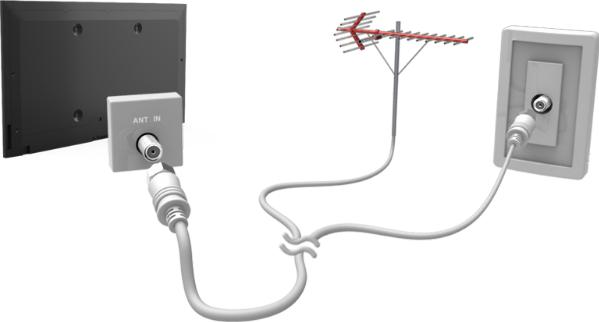
Antenna Connection
If you are not connecting your TV to a cable or satellite box, you must connect an antenna or a cable outlet to the TV to receive broadcast signals.
Connect a cable from an antenna or cable outlet to the ANT IN connector as shown in the diagram below.
"" An antenna connection is not necessary when a cable box or satellite receiver is used.
Video Device Connections
Your TV has a variety of connectors for video input from external devices such as cable boxes, satellite receivers, Blu-ray players, DVD players, camcorders, and gaming consoles. Below is a list of featured connectors shown in descending order of picture quality.
●● HDMI
●● Component
●● Composite (A/V)
Connect a video device to the TV via an HDMI connector for the best picture quality. If the device does not have an HDMI connector, try a component connector to get the next best picture quality.
"" The number of connectors and their names and locations may vary depending on the model.
"" Refer to the external device's operating manual when connecting it to the TV. The number of external device connectors and their names and locations may vary depending on the manufacturer.

HDMI Connection
The following types of HDMI cables are recommended:
●● High-Speed HDMI Cable
●●
""
""
""
""
High-Speed HDMI Cable with Ethernet
Use an HDMI cable with a thickness of 0.55 inches (14mm) or less.
Using a non-certified HDMI cable may result in a blank screen or a connection error.
Some HDMI cables and devices may not be compatible with the TV due to different HDMI specifications.
This TV does not support HDMI Ethernet Channel. Ethernet is a LAN (Local Area Network) built with coaxial cables standardized by the IEEE.
Refer to the diagram and connect the HDMI cable to the video device's HDMI output connector and the TV's HDMI input connector.
"" The number of connectors and their names and locations may vary depending on the model.
Once the connection has been made, press the SOURCE button to select the connected external device.
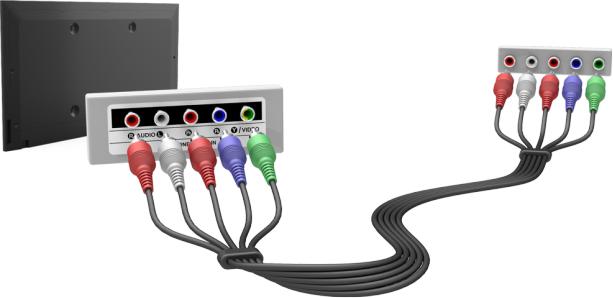
Component Connection
Refer to the diagram and connect the Component cable to the TV's component input connectors and the device's component output connectors.
Make sure the cable colors match the connector colors.
Once the connection has been made, press the SOURCE button to select the connected external device.

Composite (A/V) Connection
Refer to the diagram and connect the AV cable to the TV's AV input connectors and the device's AV output connectors.
If you are using the TV's AV input connectors, connect the device's audio output to the TV using a Y connector.
Once the connection has been made, press the SOURCE button to select the connected external device.

Audio Input and Output Connections
Your TV has a variety of connections for audio input from devices such as Blu-ray players and DVD players and for audio output to such devices as amplifiers. The connections are listed below.
●●
●●
""
""
""
Digital Audio (Optical)
Audio (Analog)
For better audio quality, it is a good idea to use an AV receiver.
The number of connectors and their names and locations may vary depending on the model.
Refer to the external device's operating manual when connecting it to the TV. The number of external device connectors and their names and locations may vary depending on the manufacturer.
"" When connecting the external device to the external speaker, be sure to connect the external speaker to the TV first, and then connect the external device. Sync problems may develop if the connection order is reversed.
Digital Audio (Optical) Connection
Connecting an AV receiver to the TV via a digital audio (optical) connector lets you listen to digital audio.
"" Connecting a device using an optical cable does not automatically turn off the TV speakers. To turn off the TV's speakers, set TV Sound Output (Sound > Speaker Settings > TV Sound Output) to something other than TV Speaker.
"" Adjust the audio device's volume using its remote control.
"" An unusual noise coming from the audio device while you are using it may indicate a problem with the audio device itself. If this occurs, ask for assistance from the audio device's manufacturer.
"" Digital audio is only available with 5.1-channel broadcasts.
Refer to the diagram and connect the optical cable to the TV's digital audio output connector and the device's digital audio input connector.
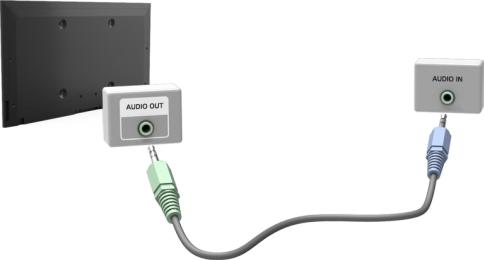
Audio Output Connection
Refer to the diagram and connect an audio cable to the TV's audio output connector and the device's audio input connector.
Connecting to a Computer
You can connect a computer directly to the TV using an HDMI or DVI to HDMI cable and use the TV as a monitor. You can also connect the TV to a computer via your home network and access media files saved on the computer on the TV screen. The kinds of connections you can make are listed below.
To use the TV as a Computer Monitor
●● Connect through the HDMI Port using an HDMI cable.
You can connect the computer to the TV using an HDMI cable and display the computer screen on the TV.
●● Connect though the HDMI (DVI) port using a DVI to HDMI cable.
You can connect a computer to the TV by connecting the computer's DVI port to the TV's HDMI (DVI) port with a DVI to HDMI cable and display the computer screen on the TV.
To Access Media Files on a Computer and View or Play Them on the TV
●● Connect Through Home Network.
Quickly access photo, video, and music files saved on a computer by connecting the TV and the computer to the same router or AP.
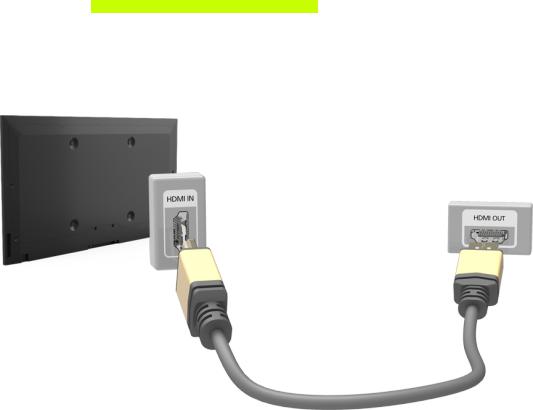
Connecting Through the HDMI Port
For an HDMI connection, we recommend one of the following HDMI cable types:
●● High-Speed HDMI Cable
●● High-Speed HDMI Cable with Ethernet
"" Use an HDMI cable with a thickness of 0.55 inches (14mm) or less. Using a non-certified HDMI cable may result in a blank screen or a connection error.
"" Some HDMI cables and devices may not be compatible with the TV due to different HDMI specifications.
"" This TV does not support HDMI Ethernet Channel. Ethernet is a LAN (Local Area Network) built on coaxial cables standardized by the IEEE.
"" Many computer graphics adaptors do not have HDMI ports, but have DVI ports instead. If your computer graphics adaptor has a DVI port, use a DVI to HDMI cable to connect the computer to the TV. For more information, refer to "Connecting With a DVI to HDMI Cable".
Refer to the diagram and connect an HDMI cable to the computer's HDMI output connector and the TV's HDMI input connector.
"" The number of ports, and their names and locations may vary depending on the model.
Once the connection has been made, press the SOURCE button to select the connected external device.
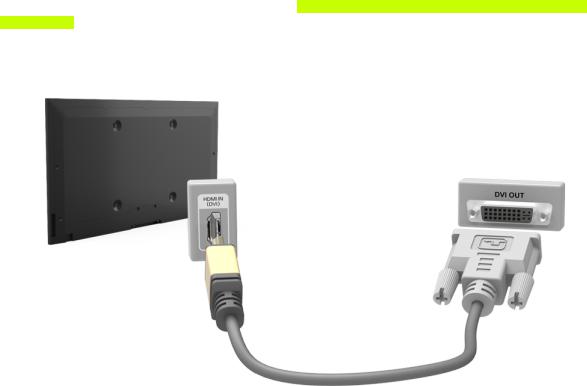
Connecting With a DVI to HDMI Cable
If the graphics adapter of your computer does not support the HDMI interface, connect the computer to the TV with a DVI (Digital Visual Interactive) to HDMI cable. Note that the DVI to HDMI connection is only supported by the HDMI (DVI) port and does not support audio signal transmission. To listen to the computer sound, connect external speakers to the computer’s audio output connector.
"" For the resolutions supported by the TV, refer to "Read Before Connecting a Computer (Supported
Resolutions)".
Refer to the diagram and connect the DVI to HDMI cable to the TV's HDMI (DVI) port and the computer's DVI output port.
Once the connection has been made, press the SOURCE button to select the connected external device.
Connecting Through Home Network
Quickly access and play photo, video, and music files stored on a computer on the TV.
1.Connect the TV and the computer to the same router or AP. Once you connect them to the same router or AP, a home network is configured.
2.On the computer, select [Control Panel] > [Network and Internet] > [Network and Sharing Center] > [Change advanced sharing settings], and then select [Choose media streaming options...] to activate media streaming.
3.From the list, set the TV to [Allowed].
4.Launch Windows Media Player on a computer. Select [Settings] > [Library Management], and then add the location where photo, video, and music files are saved to play them on the TV.
"" Alternatively, you can move the files to the default folder specified by Windows Media Player, and then play or view them on the TV.
"" As long as File Sharing is activated, unauthorized access may occur. When you do not need to access data, disable File Sharing.
Connecting To a Mobile Device
You can connect a mobile device such as a smartphone or tablet directly to the TV, or connect it to the network and display the mobile device's screen or play its content on the TV. The kinds of connections you can make are listed below.
●● Connect by Mirroring the Mobile Device's Screen on the TV (Screen Mirroring)
Wirelessly connect the TV and the mobile device with the mirroring function. You can view the mobile device's screen on the TV screen.
"" This option is available only on a mobile device that supports the mirroring function.
"" This option may differ from the mobile's software.
●● Connect Mobile Devices without a Wireless Router (Wi-Fi Direct)
Wi-Fi Direct enables you to connect the TV and the mobile device without a router or AP. Quickly access and play photo, video, and music files in the connected mobile device on the TV.
"" This option is available only on a mobile device that supports the Wi-Fi Direct function.
●● Connect Through Home Network
You can conveniently play photo, video, and music files saved on a mobile device by connecting the mobile device and the TV to the same router or AP.

Screen Mirroring
"" This option may differ from the mobile's software.
MENU > Network > Screen Mirroring Try Now
Wirelessly connect a mirroring-enabled mobile device to the TV and play the video and audio files stored on the device on the TV. Mirroring refers to the function that plays the video and audio files located on a mobile device on a TV and on the mobile device simultaneously.
"" To use the Screen Mirroring function, the mobile device must support a mirroring function such as AllShare Cast or Screen Mirroring. To check whether your mobile device supports the mirroring function, please visit the mobile device manufacturer's website.
"" The video or audio may intermittently stop depending on network conditions.
Connecting via a mobile device
1.On the mobile device, run Screen Mirroring. The mobile device searches for available devices to connect to.
2.In the search result list, select the TV. The TV displays a pop-up at the top of the screen.
3.In the pop-up, select Allow to connect the mobile device.
""
""
All previously allowed mobile devices will automatically connect without needing approval.
If you select Deny, the device cannot connect. In addition, you are setting the device's connection status to Deny and it will not be able to connect in the future unless you change its connection status. To change the connection status of a denied device, Navigate to Network > Screen Mirroring > Device Manager, select the device, and then select Allow.
Connecting by Automatically Allowing the Connection
1.Navigate to Network > Screen Mirroring, and then select Screen Mirroring. The Screen Mirroring function starts. You can also start screen mirroring by pressing the SOURCE button on your remote, and then selecting Screen Mirroring from the list at the top of the screen.
2.Launch Screen Mirroring on your mobile device. The device searches for available devices.
3.Select the TV from the list. The TV automatically allows the connection and the device connects.
"" If the mobile device cannot connect, try turning the TV off and on.
Managing the Connection Status of Previously Connected Mobile Devices
"" This function is only available if devices have previously connected to the TV or have previously attempted to connect and been denied.
1.Navigate to Network > Screen Mirroring > Device Manager. The TV displays a list of devices that have previously connected to the TV or have tried to connect to the TV and been denied. The status of the connection (Allow/Deny) is also displayed.
2.Select a device. A pop-up appears.
3.In the pop-up, you can select Allow connection, Deny connection, or Delete the device from the list.

Connecting Mobile Devices without a Wireless Router (Wi-Fi Direct)
Navigate to MENU > Network > Wi-Fi Direct Try Now
You can connect a mobile device with the Wi-Fi Direct feature directly to the TV without using a wireless router or AP. By connecting a mobile device to the TV through Wi-Fi Direct, you can play photo, video, and music files saved on the mobile device on the TV.
"" This option is available only on a mobile device that supports the Wi-Fi Direct function. Please check if your mobile device supports Wi-Fi Direct.
"" The video or audio may intermittently stop depending on network conditions.
1.Enable Wi-Fi Direct on the mobile device, and then navigate to Network and select Wi-Fi Direct on the TV. The TV automatically scans for and displays a list of available devices. The TV's name also appears on the mobile device.
2.Select the device from the list to initiate a connection. If a connection request is made by the TV, a permission message appears on the mobile device and vice versa.
3.Allow the connection. The TV and mobile device connect.

Connecting Through Home Network
Quickly access and play photo, video, and music files stored on a mobile device on the TV.
1.Connect both the TV and the mobile device to the same router or AP. Once you connect them to a single router or AP, a home network is configured.
2.Enable File Sharing on the mobile device. You can play the content shared on the mobile device on the TV.
"" As long as File Sharing is active, unauthorized access can occur. When you do not need to access data, disable File Sharing.
Specifying the Name of the TV on a Network
MENU > Network > Device Name Try Now
Choose or specify a name for the TV that will appear on mobile devices and laptop computers.
1.Select Device Name from the Network menu, and then choose a name from the list that appears. Alternatively, select User Input to enter a name manually.
2.Check the name from a mobile device or laptop computer.
Switching Between Video Sources
Press the SOURCE button to switch between external devices connected to the TV. For example, to switch to a game console connected to the second HDMI connector, press the SOURCE button. The Source List appears across the top of the screen. From the Source List, select HDMI2.
"" The connector names may vary depending on the product.
Other Functions Available When You Display the Source List
A number of functions are available in the pop-up Options menu when the TV displays the Source List. The functions that appear in the Options menu vary, depending on the source you selected in the Source List and the external device connected to the source.
To view the Options menu, press the TOOLS button or press and hold the E button.
The functions that appear in the Options menu can include any of the following:
●● Edit Name: Lets you assign a device name to an input source, for example, Blu-ray to HDMI1. To assign a device name to an input source, follow these steps:
1.Open the Source List. The list appears in a horizontal line across the top of the TV. Using your remote, highlight the source you want to assign a device name to.
2.Select Edit Name in the Options menu. The on-screen keyboard appears.
3.Using the keyboard, enter a new name. You can enter up to 15 characters.
4.When finished, select DONE on the keyboard, and then press the E button.
●● Information: View information about the connected devices.
●● Remove USB: Use to safely remove a USB device connected to the TV. This option is only available when a USB device has been selected.
●● Anynet+ (HDMI-CEC): Displays a list of Anynet+ (HDMI-CEC)-compliant devices that are connected to the TV.
"" This function is not available on certain models in specific geographical areas.
"" This option is only available when Anynet+ (HDMI-CEC) is set to On.

Controlling the TV with a Keyboard
MENU > System > Device Manager > Keyboard Settings Try Now
Connecting a keyboard makes it easy to control most of the functions on the TV.
"" Certain models do not support USB HID class keyboards.
Connecting a Keyboard
Connecting a USB Keyboard
Plug the keyboard cable into the TV's USB port. A connection message appears on the screen.
Using the Keyboard
Use the following remote features with the USB keyboard connected to the TV.
●● Arrow Keys (moving the focus), Windows Key (MENU Button), Menu List Key (TOOLS Button), Enter Key (Select/run item), ESC (RETURN Button), Number Keys (Number Buttons)
●● F1 (a), F2 (b), F3 ({), F4 (}), F5 (SMART HUB), F6 (SOURCE Button), F7 (CH List), F8 (¢ Button), F9/F10 (Volume Buttons), F11 / F12 (Channel Buttons)
●● Page Up/Page Down: Scroll web browser pages up/down.
●● Press and hold the Enter key: On the Smart Hub screen, navigate to an item and press and hold the Enter key to display the Options menu.
Changing Keyboards Try Now
Select System > Device Manager > Keyboard Settings > Select Keyboard. Designate which keyboard to use.
"" Only one keyboard can be used at a time.

Input Languages, Keyboard Type, and Switch Language Key
Select System > Device Manager > Keyboard Settings > Keyboard Options. The following options are available: Try Now
●● Keyboard Language
If the keyboard supports multiple languages, choose the language you want to use from the displayed list.
●● Keyboard Type
Match the Keyboard Type to the language selected in Keyboard Language.
"" The Keyboard Type list varies depending on which language was selected under Keyboard Language.
●● Switch Input Language
If the keyboard supports multiple languages, choose the key you want to use to switch between languages.
Controlling the TV with a Mouse
MENU > System > Device Manager > Mouse Settings Try Now
Connecting a mouse makes it easy to control most of the functions on the TV.
"" Certain models do not support USB HID class mice.
Connecting a Mouse
Connecting a USB Mouse
Plug the mouse cable into the TV's USB port. A connection message appears on the screen.

Using the Mouse
Once a USB mouse is connected to the TV, a pointer appears on the TV's screen. You can use this pointer to control the TV in the same way you use a pointer on a computer.
●● Selecting and Running an Item
Left-click using the mouse.
●● Showing Tools Buttons
Right-clicking displays the Tools buttons on the screen so that you can easily use the TV's functions.
"" The Tools buttons may vary depending on the function your are using.
●● Scrolling the TV Menu or Screen
Move the mouse wheel up or down. This scrolls the TV menu or screen up/down.
●● Exiting the TV Menu or Feature
Click the X button. This closes the menu.
"" The X button appears on the TV menu when a mouse is being used. Left-clicking once while using a feature displays the X button on the current screen.
Changing Mice Try Now
Select System > Device Manager > Mouse Settings > Select Mouse. Designate which mouse to use.
"" Only one mouse can be used at a time.
Changing Mouse Buttons and Pointer Speed Try Now
Select System > Device Manager > Mouse Settings > Mouse Options. The following options are available:
●● Primary Button
Choose which button (left or right) to use to select and run items.
●● Pointer Speed
Adjust the movement speed of the pointer that appears on the screen.
Entering Text Using the On-Screen QWERTY Keypad
A QWERTY keypad appears when you need to enter text (entering the network password, logging into your Samsung account, etc.), allowing you to enter text using your remote control.
Using Additional Functions
Select  on the QWERTY keyboard screen. The following options are available:
on the QWERTY keyboard screen. The following options are available:
●● Recommended text
Enable/disable the Recommended Text feature Enabling the Recommended text feature allows you to quickly enter text starting with the characters you typed in by displaying recommended words. To enter the word "Internet," for example, all you have to do is enter "In" and select the word "Internet" from the list of recommended words. The word is memorized so that you can enter the same text again more easily.
●● Reset recommended text data
Delete both the recommended words and the memorized words to clear the list.
●● Predict Next Letter
Enable/disable the Text Prediction feature. Enabling the Text Prediction feature eliminates the need to find and select individual character keys. To enter the word "Internet," for example, select "I". A predicted word will then appear next to the I key. Simply select the predicted word to enter "Internet".
"" This feature is limited to words that have previously been added to the dictionary.
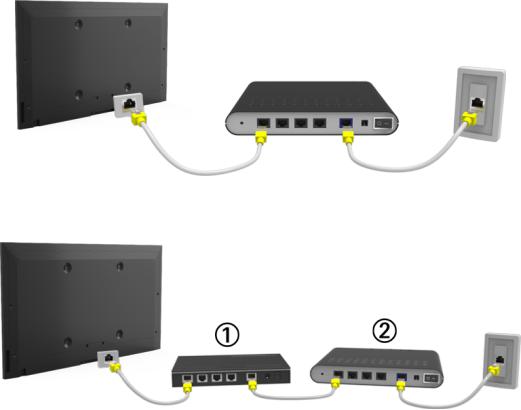
Establishing a Wired Internet Connection
Connecting the TV to the Internet gives you access to online services and SMART features, and lets you update the TV's software quickly and easily through the Internet.
Using Cat 7 LAN Cables
We recommend using Cat 7 LAN cables to link your TV to the Internet Access Points.
"" The TV will not be able to connect to the Internet if the network speed is below 10Mbps.
There are three ways to connect the TV to your Internet Access Points. Using Cat 7 cables, connect the TV to the Access Points as shown in one of the following illustrations.
●● External Modem
●● IP Router + External Modem

●● Wall-mounted LAN Outlet
Connecting to a Wired Internet Network Automatically
MENU > Network > Network Settings Try Now
Automatically connect to an available network.
1.Set the Network type to Wired, and then select Connect.
2.The TV attempts to connect to an available network. Once it is successful, you will see a confirmation message. Select OK. If the attempt fails, try again, or connect manually.

Connecting to a Wired Internet Network Manually
MENU > Network > Network Settings
With networks that require a static IP address, you will need to enter the IP address, subnet mask, gateway, and DNS values manually to connect to the network. To get these values, contact your Internet Service Provider (ISP).
""
1.
Refer to the "Dynamic versus Static IP Addresses" section for more information on dynamic IP and static IP addresses.
Set the Network type to Wired, and then select Connect.
Network Settings
Select your network type.
Network type |
Wired |
Connect
You can connect your
TV to the internet.
2.Select Stop when the TV attempts to connect to the network. Once the network connection has been interrupted, select IP Settings.
Network Settings
Connection verification cancelled.
Wired network connection test is stopped. |
|
||
Change Network |
IP Settings |
Retry |
Close |

3.In the IP Settings screen, set IP Setting to Enter Manually.
|
IP Settings |
IP Setting |
Enter Manually |
IP Address |
0.0.0.0 |
Subnet Mask |
0.0.0.0 |
Gateway |
0.0.0.0 |
DNS Setting |
Enter Manually |
DNS Server |
0.0.0.0 |
OK |
Cancel |
4.Select IP Address. When the IP Address entry window appears, enter three digits into each field on the IP Address line. If the value has less than three digits, add leading zeroes. For example, to enter 10, enter 010. After three digits have been entered in a field, the highlight automatically jumps to the next field.
"" Enter numbers by pressing the number buttons. After you have filled in all four fields, press the E button again.
5.Repeat the process for Subnet Mask, Gateway, and DNS Server.
6.When done, select OK.
7.The TV attempts to connect to the network again using the settings you entered. Once it has established the connection, it displays a confirmation message. Select OK.
"" The network connection speed may differ depending on the DNS server settings.
"" For details on the DNS server settings, contact your Internet service provider (ISP).
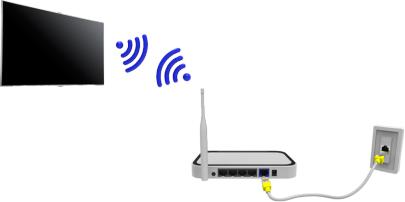
Establishing a Wireless Internet Connection
Connecting the TV to the Internet gives you access to online services and SMART features, and lets you update the TV's software quickly and easily through the Internet.
Connecting to a Wireless Internet Network Automatically
MENU > Network > Network Settings
Connect the TV to the Internet via a wireless router. Make sure you have the wireless router's SSID (name) and password settings before attempting to connect. The password can be found on the wireless router's configuration screen.
1.On the Network Settings screen, set Network type to Wireless. The TV automatically displays a list of available wireless networks.
2.Select a network. If the network you want doesn't appear in the list, select Add Network, and enter the network's SSID (name) manually.
3.Using the on-screen keyboard that appears, enter the password. When finished, select Done. If the selected network is not security-enabled, the TV will by-pass the on-screen keyboard and attempt to connect right away.
–– To select a character on the on-screen keyboard, highlight the character and then select it. Select Caps to view capital letters. Select the 123#& key to view additional characters.
–– To view the password as you enter it, select Show Password.
4.The TV attempts to connect to the network. Once a connection is established, the TV displays a confirmation message. Select OK. If the attempt fails, try again or connect manually
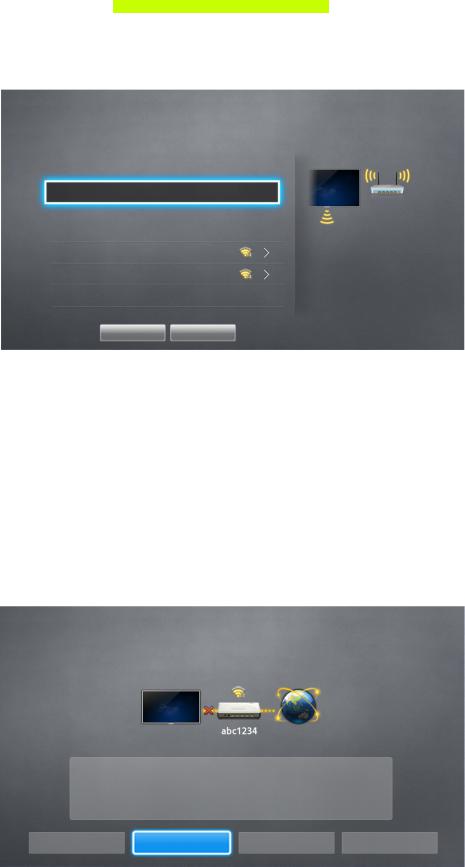
Connecting to a Wireless Internet Network Manually
MENU > Network > Network Settings
With networks that require a static IP address, you will need to enter the IP address, subnet mask, gateway, and DNS values manually to connect to the network. To get the IP address, subnet mask, gateway and DNS values, contact your Internet Service Provider (ISP).
"" Refer to the "Dynamic versus Static IP Addresses" section for more information on dynamic IP and static IP addresses.
1.On the Network Settings screen, set Network type to Wireless. The TV automatically displays a list of available wireless networks.
Network Settings
Select your network type.
Network type |
Wireless |
Wireless network
AP0000
AP0001
Add Network
You can connect your TV to the internet. Please select which wireless network to use.
Refresh |
WPS (PBC) |
2.Select a network. If the network you want doesn’t appear in the list, select Add Network, and enter the network’s SSID (name) manually.
3.Using the on-screen keyboard that appears, enter the password. When finished, select Done. If the selected network is not security-enabled, the TV will by-pass the on-screen keyboard and attempt to connect right away.
–– To select a character on the on-screen keyboard, highlight the character and then select it. Select Caps to view capital letters. Select the 123#& key to view additional characters.
–– To view the security password as you enter it, select Show Password.
4.Select Stop when the TV attempts to connect to the network. Once the network connection has been interrupted, select IP Settings.
Network Settings
Connection verification cancelled.
Wireless network connection test is stopped. |
|
||
Change Network |
IP Settings |
Retry |
Close |
